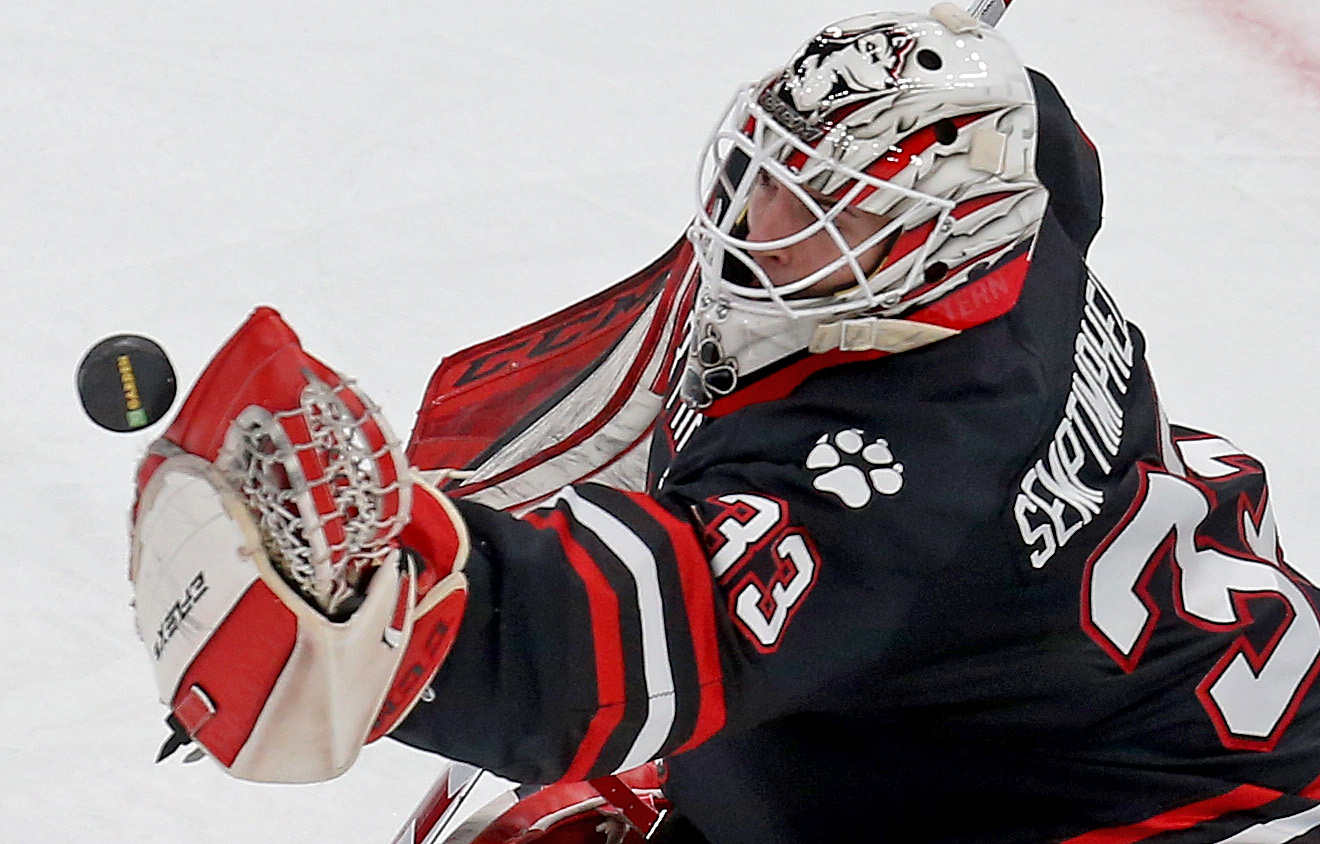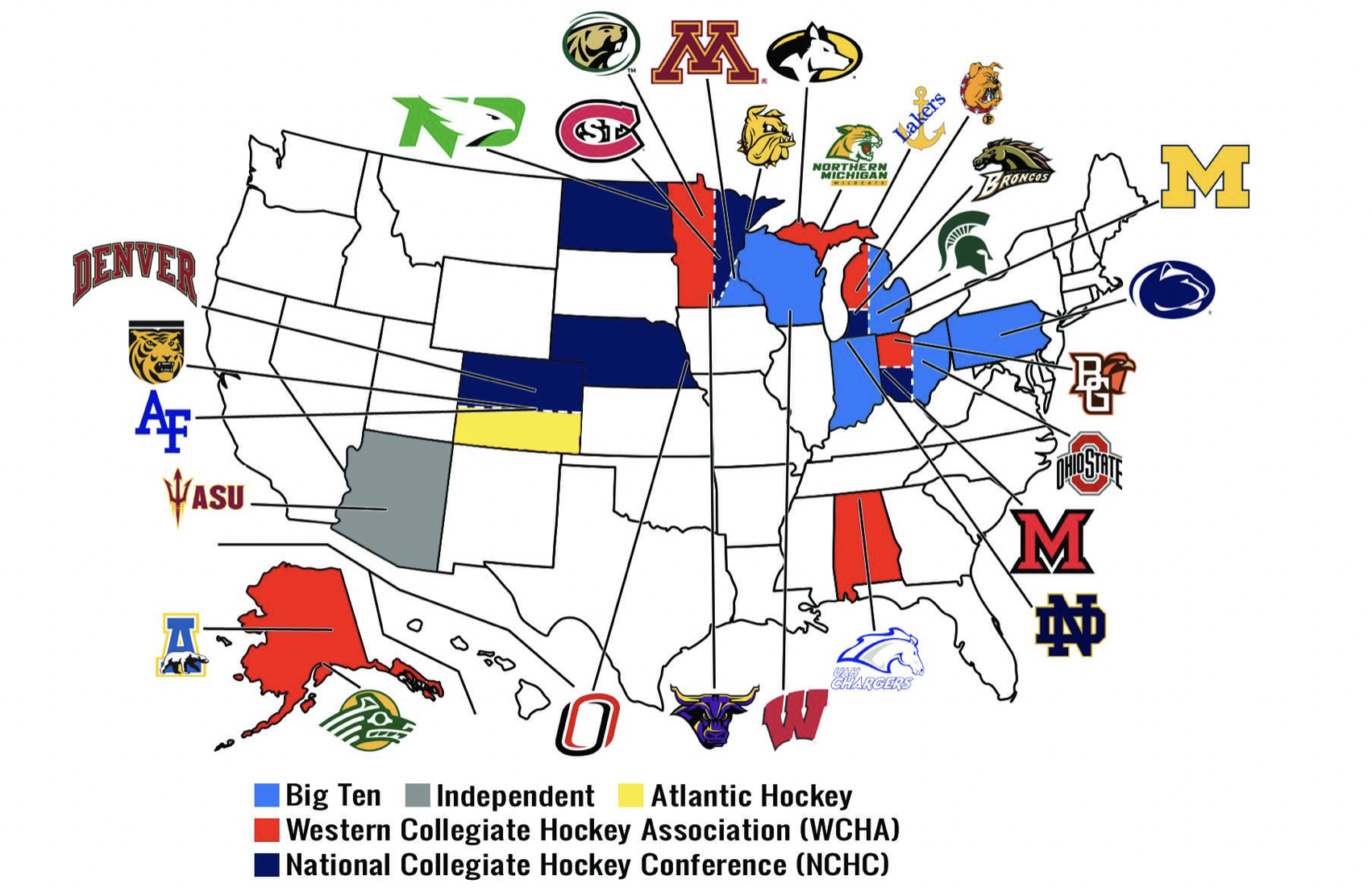© 2025 ALLCITY Network Inc.
All rights reserved.

In a perfect world, the Arizona State men’s hockey team would have moved into its new arena two summers ago. The Sun Devils were headed toward a second straight NCAA Tournament berth when the global pandemic canceled the 2020 postseason. ASU had the type of momentum that would have dovetailed perfectly with a shiny new facility in college hockey’s only warm-weather, Division I location.
Between an all-road schedule in 2020-21 and a handful of near-misses against elite opponents in 2021-22, the past two years have stalled that momentum, but none of that mattered when the players toured ASU’s new multi-purpose arena for the first time on Thursday.
Enjoy this hilarious narration from soon-to-be senior defenseman Jacob Semik.
The Sun Devils’ new home is nearly complete. Test ice will go down in June and Powers expects the team to hold at least a portion of its training camp there before the season begins this fall.
“It’s getting exciting to start planning to play in a real facility and create a real home-ice advantage,” Powers said. “But most importantly, it will be exciting to see our guys play with 5,000 people behind them.”
The multi-purpose facility offers ASU another opportunity to build momentum. There are no recruiting hurdles to cross now that Oceanside Ice Arena is out of the mix, and few Division I programs can offer the sort of facilities and year-round training opportunities that ASU, a Power-Five conference school, can offer.
Powers knows this, and his staff has been busy shoring up the roster this offseason with the hope of opening the new barn with a bang.

Transfers
The transfer portal isn’t going away and it has changed the complexion of college sports. Most coaches are embracing it as a means to shore up perceived deficiencies and, in some cases, land top-shelf talent.
Powers believes that he has done that with the five transfers who will join the program this fall: forwards Robert Mastrosimone (Boston University), Lukas Sillinger (Bemidji State), Ty and Dylan Jackson (Northeastern) and goalie TJ Semptimphelter (Northeastern).
“We lost a lot up front with Colin Theisen, Jack Becker, Johnny Walker, Chris Grando and Jordan Sandhu gone and Michael Mancinelli in the portal, but we also return guys like Josh Doan and Matthew Kopperud,” Powers said. “We’re a team that likes to get up and down the ice, score, be fun to watch and most importantly, fun to play for.
“With these additions, we’re deeper than we have ever been. There’s no sugarcoating that. This transfer class is really good. It’s probably one more player than we anticipated bringing in, but we just viewed all five as kids that we couldn’t pass on. Judging by the programs that we beat in the recruiting battle, everybody else agreed.”
Mastrosimone may be the pick of the litter. The Detroit Red Wings selected him in the second round (No. 54) of the 2019 NHL Draft. A product of the Chicago Steel’s powerhouse USHL program, Mastrosimone had 60 points in 54 games for the Steel in 2018-19, and he had 11 goals and 25 points in 34 games at BU last season.
Dillinger isn’t far behind, if at all. The son of former Coyote Mike Sillinger, Lukas had 17 goals and 38 points in 37 games for Bemidji last season.
Powers said that ASU was the runner-up for the Jackson brothers before they committed to Northeastern. Dylan only played eight games last season due to injury, but Powers likes both players’ hockey IQ and skill level. Both topped 50 points with Dubuque in the USHL two seasons ago.
The final piece of the transfer puzzle is Huskies goalie TJ Semptimphelter, who stopped 69 of 71 shots over two games of Boston’s famed Beanpot tournament with Harvard, Boston University, Boston College and Northeastern to win the Eberly Award, which is presented annually to the Beanpot goalie with the best save percentage.
The Sun Devils finished tied for 36th (out of 59 teams) in save percentage last season at .898. Goaltending was a major reason that the Sun Devils fell short of the NCAA Tournament.
“The biggest area we wanted to address was in net and we think we got our guy in TJ,” Powers said. “He spent his freshman season backing up Devon Levi, who may be the best goalie that college hockey has ever seen statistically (Levi led Division I with a .952 save percentage).
“What TJ did in his eight games when Devin was at the Olympics is remarkable. He’s incredibly athletic, but he’s not like the new-age goalie where he’s a huge shot blocker. He’s an athlete and he’s very cerebral. He’s quick and he’s in incredibly good shape. He’s more like a Joey Daccord style goalie that we had a lot of success with.”
Freshman class
Powers has seven freshmen coming in, with an eighth a possibility up front.
Forward Charlie Schoen had 26 goals and 56 points in 58 games for Sioux City (USHL) last season. Blake Dangos (Madison, USHL) and 6-feet-2, 216-pound Tucker Ness (Waterloo, USHL) add some needed defending to a blue line that already features Ty Murchison and Tim Lovell on the top pair, along with Semik, Ethan Szmagaj, Jack Judson and Tanner Hickey.
Forward Teddy Lagerback joins the team out of Trail (BCHL), where he had 25 goals and 49 points in 54 games last season. Center Ryan Alexander brings a two-way game from the USHL, where he had 18 goals and 34 points in 59 games split between Youngstown and Fargo. Forward Ryan Robinson joins from Wichita Falls of the NAHL where he had 20 goals and 52 points in 58 games.
The final piece (for now) is Chicago Steel goalie Gibson Homer, who is still just 18 and stands 6 feet 5. Powers calls him “a huge, raw talent with a lot of potential and lot of development ahead” with goalie coach Eddie Läck.
Schedule
The Sun Devils’ 39-game schedule sets up nicely for a return to the NCAA Tournament.
There are 24 home games and just 15 road games, four of which will take place in the season’s first two weekends at Minnesota Duluth and Bemidji State. ASU will play three series vs. 2021 Frozen Four teams (home vs. Minnesota State and Minnesota; road vs. national champ Denver). They’ll also face North Dakota in the U.S. Hockey Hall of Fame game at T-Mobile Arena in Las Vegas on Oct. 29.
The return of the Desert Classic in early January will feature Boston University, Air Force and Michigan Tech. That tournament comes in the middle of a 10-game homestand that begins with a series against Boston College from Dec. 30-31.

Conference affiliation
It has been clear for the past few seasons that ASU would not be able to join a conference before it had its arena in place. The multi-purpose arena paves the way for that move, but per sources, the Sun Devils are weighing multiple options:
- Join the Big Ten where they played a full schedule in 2020-21.
- Join the National Collegiate Hockey Conference (NCHC).
- Remain independent.
There are advantages and disadvantages to each. From an institutional profile standpoint, the Big Ten makes the most sense. The schools have similar facilities, resources, academic standards and those programs would probably draw better crowds to ASU, although ticket sales are not going to be a problem for the Sun Devils.
On the flip side, playing in the Big Ten would require a lot of travel (and cost) across at least one time zone, perhaps two all season if the House of Representatives makes daylight saving permanent (the Senate has already passed its bill).
The NCHC may seem closer geographically, but some of its schools do not sit near airports, requiring an additional bus trip upon landing. The schools also offer less in terms of profile, although North Dakota has a storied tradition and Denver just won the national championship.
There has been some speculation in the past that the NCHC could splinter and create opportunities for ASU. Could the Sun Devils persuade Denver and Colorado College to form a western-based conference? Could they also persuade Air Force (Colorado Springs) to abandon its illogical move to the Atlantic Hockey Conference where its only advantage is playing fellow service academy Army? Is there an appetite for any teams in the Pac-12 to add hockey amid rising costs, NIL deals and Title IX requirements?
The Sun Devils have already proven that they can make the tournament as an independent. The concern has been the amount of idle time that elapses between the end of the regular season and the start of the NCAA Tournament. Conference teams play conference tournaments to prepare for the NCAA Tournament.
ASU does not have that luxury, but recent additions have brought the field of independent opponents to four (Alaska Fairbanks, Alaska Anchorage, Long Island and Lindenwood), and Robert Morris will reinstate its program in 2023-24, affording ASU the opportunity to fill that time gap with games. That is already reflected on the 2022-23 schedule where the Sun Devils play their final 10 games against independents.
It does not sound like ASU is in any rush to make a decision.
Top photo via Getty Images: Boston University’s Robert Mastrosimone celebrates the school’s Beanpot tournament victory at TD Garden in Boston in February.
Follow Craig Morgan on Twitter
Comments
Share your thoughts
Join the conversation



